Okay, I admit it, I have an ilex problem. I collect ilex bonsai the same way that some people collect Hummel figurines, baseball cards, comic books or cats. Or even ex-husbands.
What can I say? they have small leaves, quick growth, they’re able to be kept in a small pot, cold hardy in my area, and just so darn cute.
I had thought to break this post into five different posts about each tree but I don’t want to torture you with so many little stories, so I’ll just hit on the important parts of each tree.
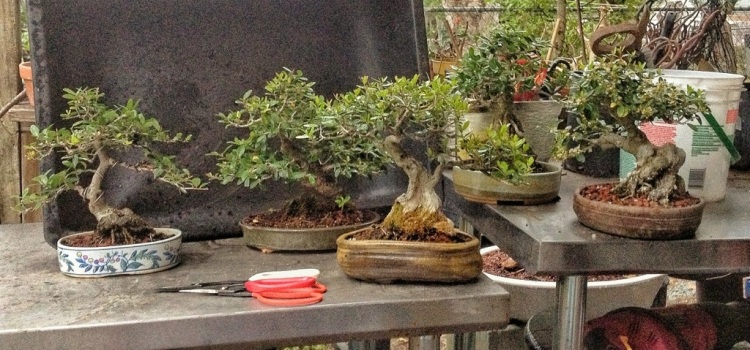
This is our cast of characters.
Let me introduce them to you.
I’ve exhibited this one before. It was in the BSF show 2 or 3 years ago.

This one in the nice porcelain pot is in its 2nd year of a rejuve. I’ll talk more about that later.
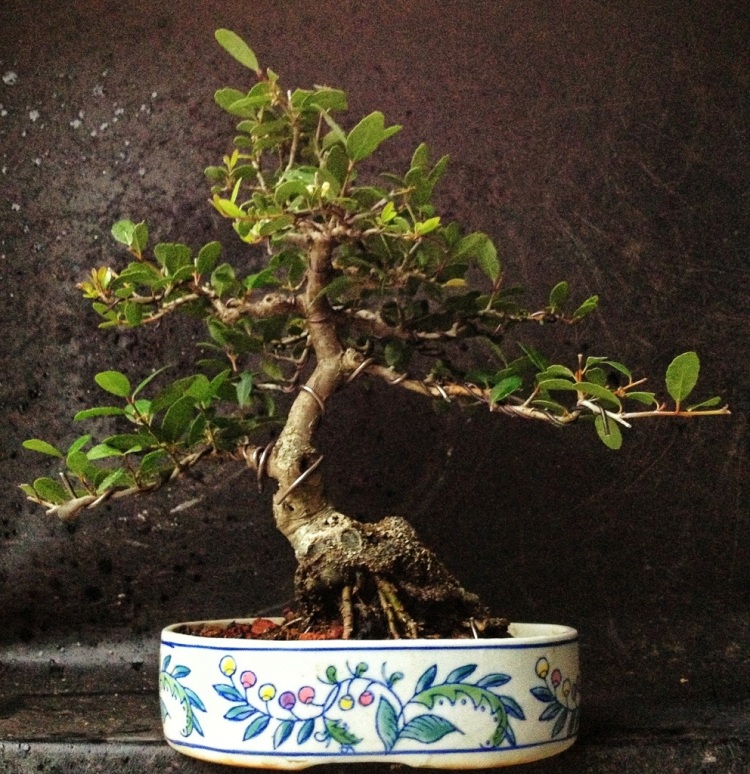
This one is a hollow trunked ilex in a handmade pot. One of my favorite. It’s a really natural looking tree.

This one is about done with the rejuve process, time for a new pot and some wire.

And this exposed root style tree needs a rejuve. It didn’t get much growth at all last year.
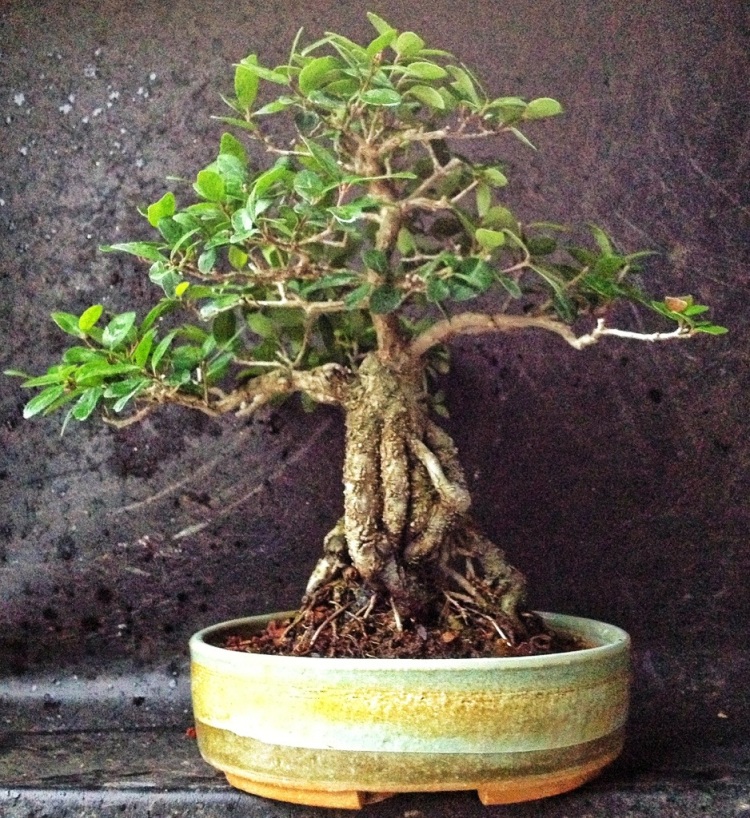
So you’re asking “what the hell is a rejuve?” Right?
As I tell each trees story I’ll explain the “rejuve” process as I’ve come to develop it for the ilex. And why it’s necessary.
First tree:
It’s about a foot tall, really good taper…

It’s in a beautiful subtlety glazed Taiko Earth pot by Rob Addonizio. It needs a repotting and some branch work.
Mainly here..
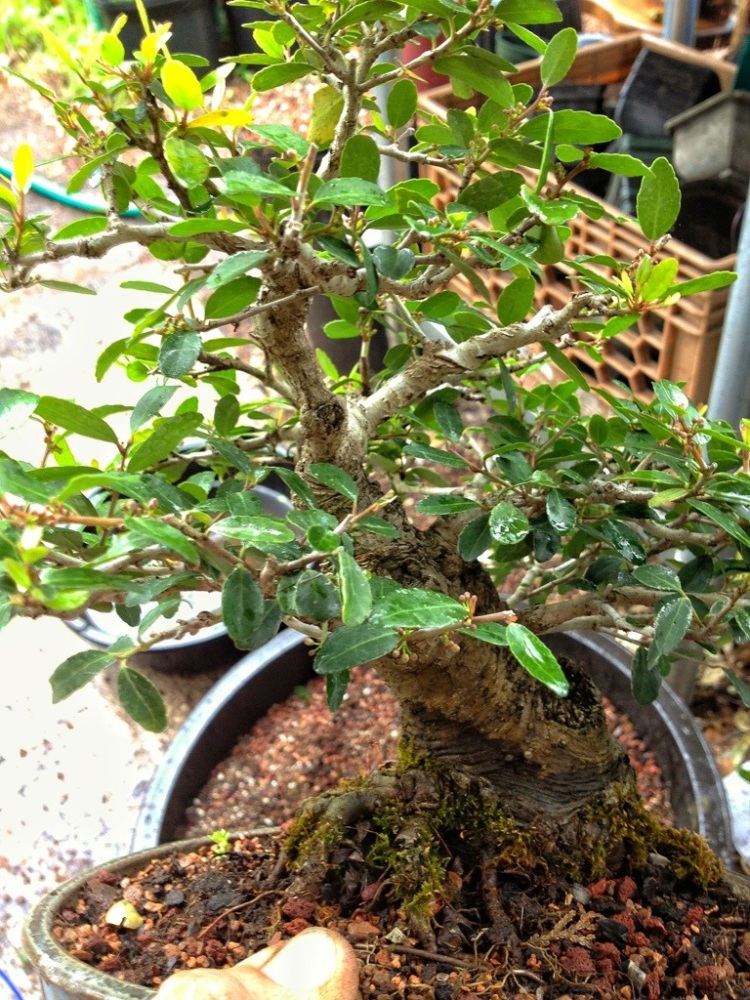
That branch is too thick with no taper.
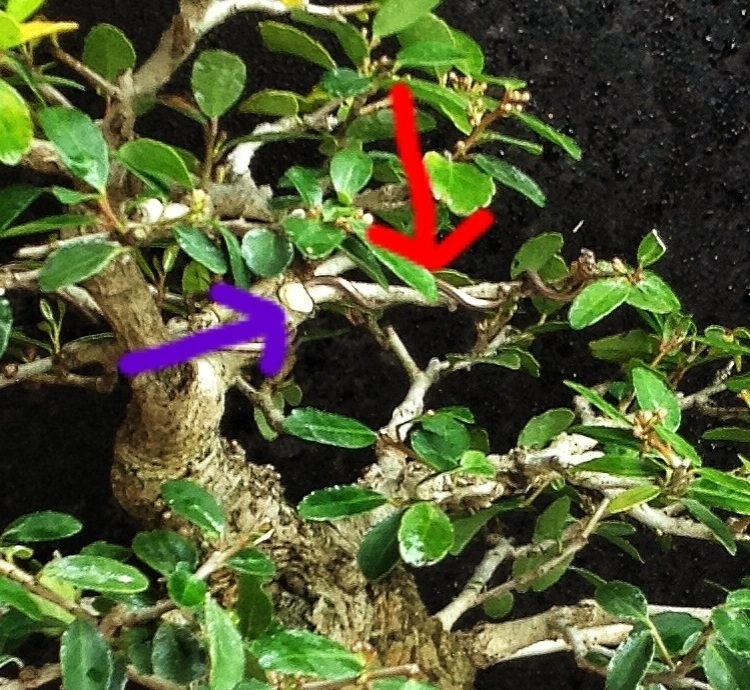
I cut it back (blue arrow) and wired a secondary branch into its old spot (red arrow). As your tree ages, it’s important that this process is done regularly. Taper is the one of the things that give age to a tree. By cutting back and re-growing taper is achieved.
Now the roots

Pretty healthy looking, I haven’t had any health issues with this tree. It’s been 2 years since I’ve repotted and you can tell by the matting in some spots. Not as bad as the “old ilex” in the previous post by any means.
It’s always best to clean the pot, especially making sure the screen on the drain holes is clean.
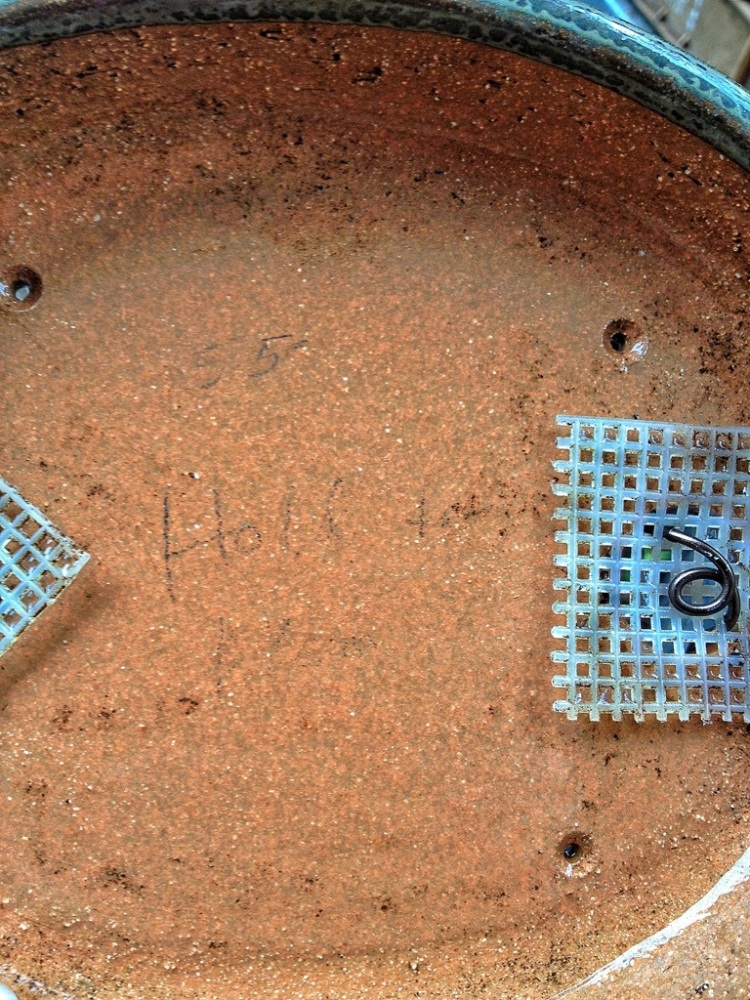
Cool. It still says “Hold for Adam”.
I’m gonna save all the finished “glamor” shots ’til the end.
Next..

It’s important to understand that we don’t need to be repotting our trees every year. Each time you do it some vigor is sapped away from the tree. The soil in this pic above is not showing too many roots (an ilex roots will fill the pot)
In late summer I restyled the branches
And cut out the older, over lignified branches and replaced them with younger ones that I let grow long.
This is important with ilex; as the branch becomes more woody and stiff, it loses its capacity to move water and nutrients. And the result is that branch withering and dying.
This is the first step in the rejuve process. Let it grow unrestricted.

Fertilize, fresh top coat of soil, and let it be this year except pruning.
Next….
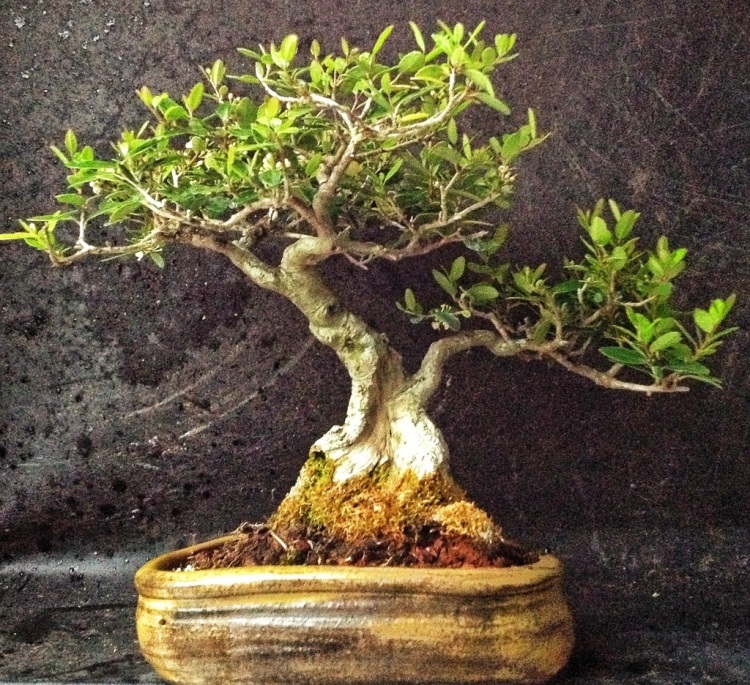
This ilex is one of my favorite: I did not repot last year so that’s definitely on the slate today.
First, clean the moss off the trunk
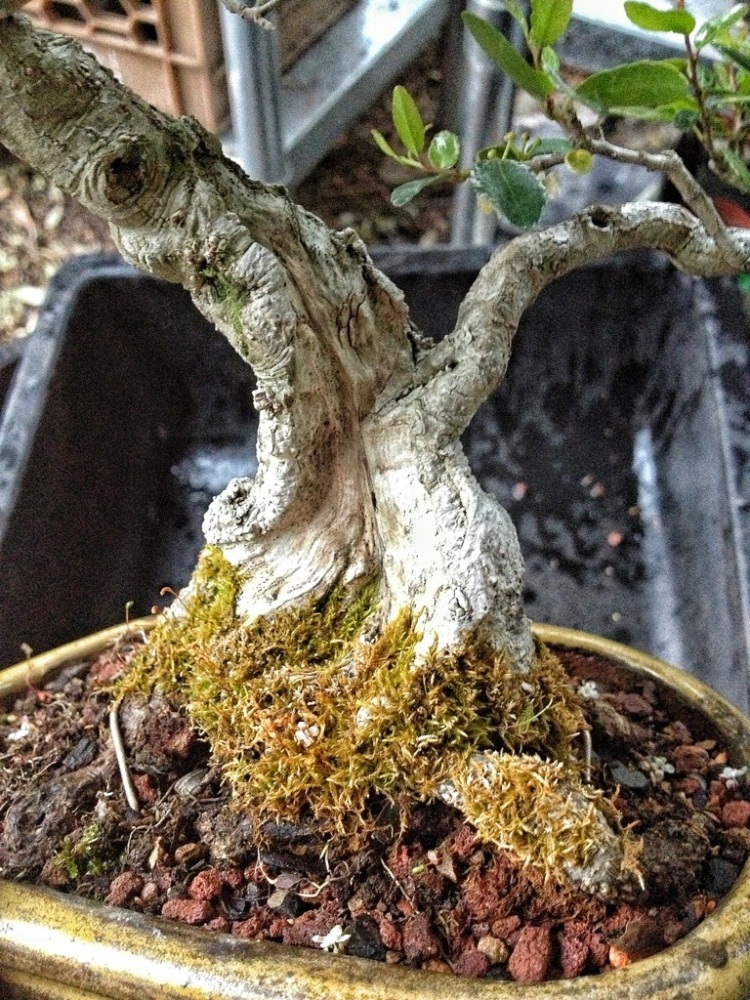
There was a nice moss layer on the soil but something removed it. I haven’t caught the beast in the act yet so I don’t know exactly what it is , but it must be faster than the cats, that’s all I have to say.
Maybe it’s the children?

If you look close you will see the fine roots on the soil surface. This happens from keeping moss on the tree. And this is why moss is a good thing on the soil surface, especially on little trees. It allows the tree to utilize the entire soil mass where, without moss, the first 1/4-1/2 inch is wasted space.
But we don’t want moss on the trunk so a toothbrush and some water and…
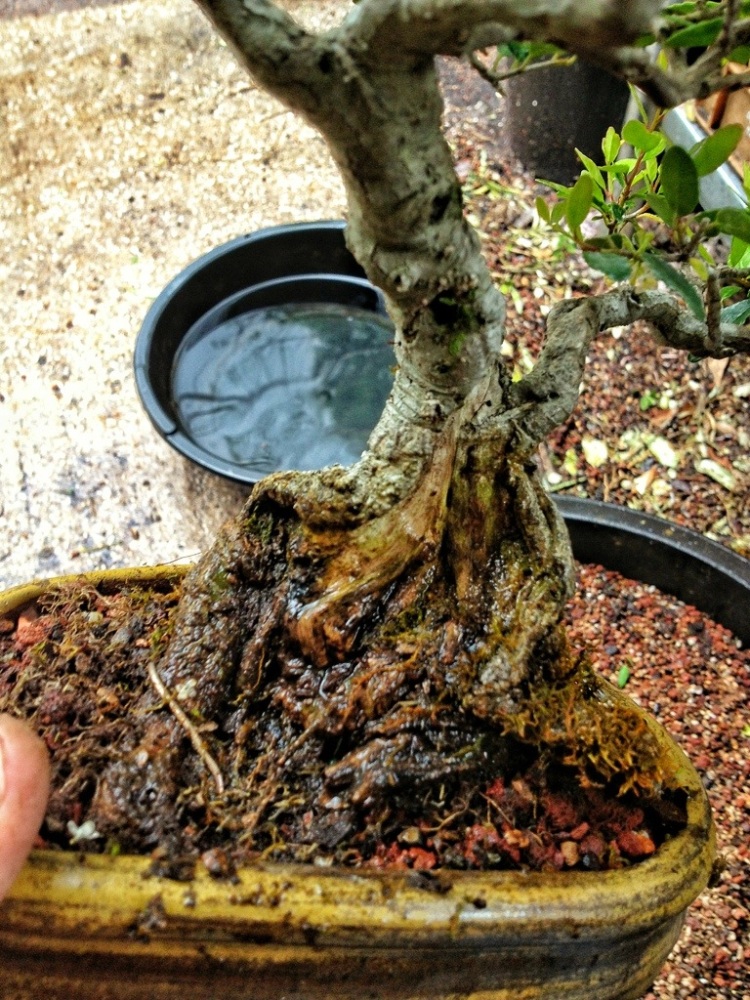
Brush brush brush brush brush brush. It’s not easy. Put some elbow grease in it man!
Here’s a tip:

If you’re re-using the same pot, (which requires cleaning, installing new tie downs etc) while preparing the old pot and the trees roots are naked, put the tree in a pan of water so the roots don’t dry out.
And you get a cool photoshop opportunity too…

Kinda looks like a painting, no?
Do you need another tip?

I don’t like fertilizer on the soil surface, it cakes up and just looks bad. I mean, who wants to see poop on the lawn?
Just tap the pot a bit and the fertilizer will disappear. That’s also why I prefer granular poop to the poop cakes.
Next tree…

This tree is at the end of the rejuve. Last year, I repotted it into a slightly larger pot with better drainage, let it grow without much trimming, and made sure that it stayed fertilized. It has a lot of flowers so it must be happy.
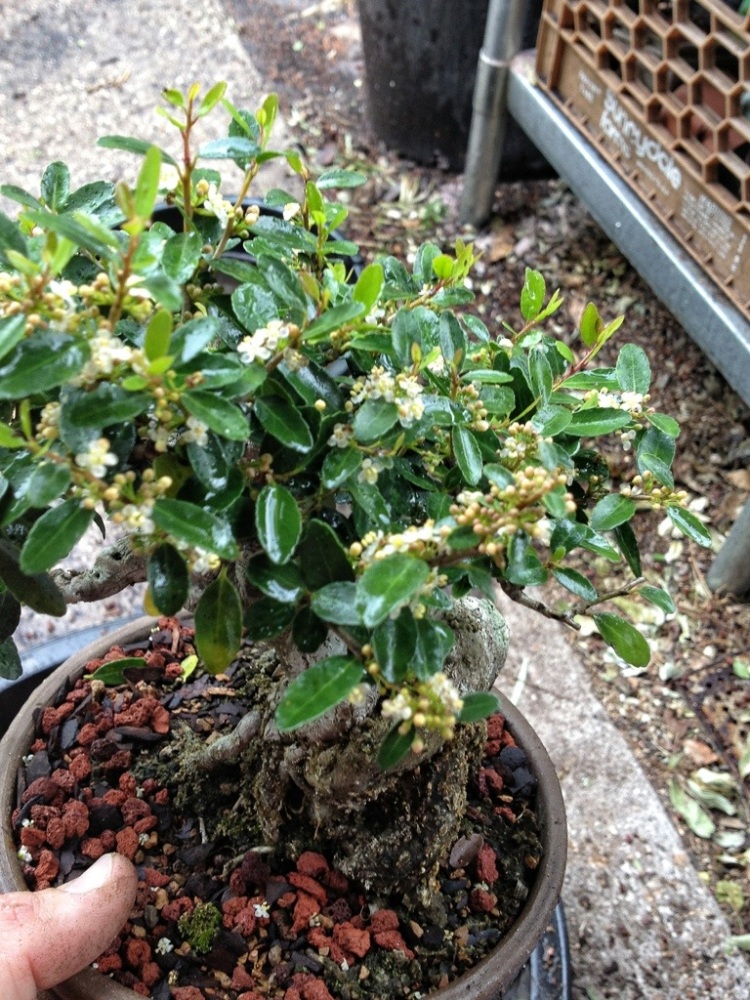
And the leaves are a terrifically dark green. Coming out of winter that’s a plus.
Before trimming:

I’m going to have to remove most of the flowers (I can hear it now “NO! Not the FLOWERS!) as I can’t wire around them.
After:

And a new pot…err, an old pot.
This is an old Korean pot that either is dirty or has patina.

It looks good wet (and oiled up for a show) but wait until you see it dry.
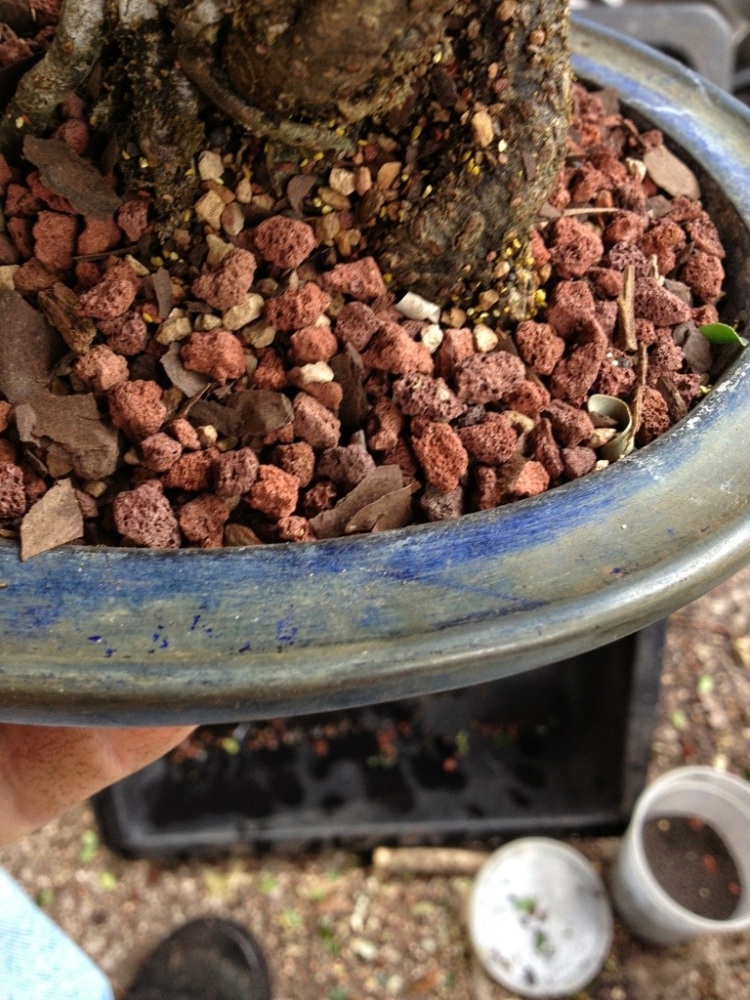
What do you think? Patina?
Next tree…

Last year I watched this tree just sit. It got very little growth (which can sometimes be a blessing here in Florida, but not in this case. ) and as you see
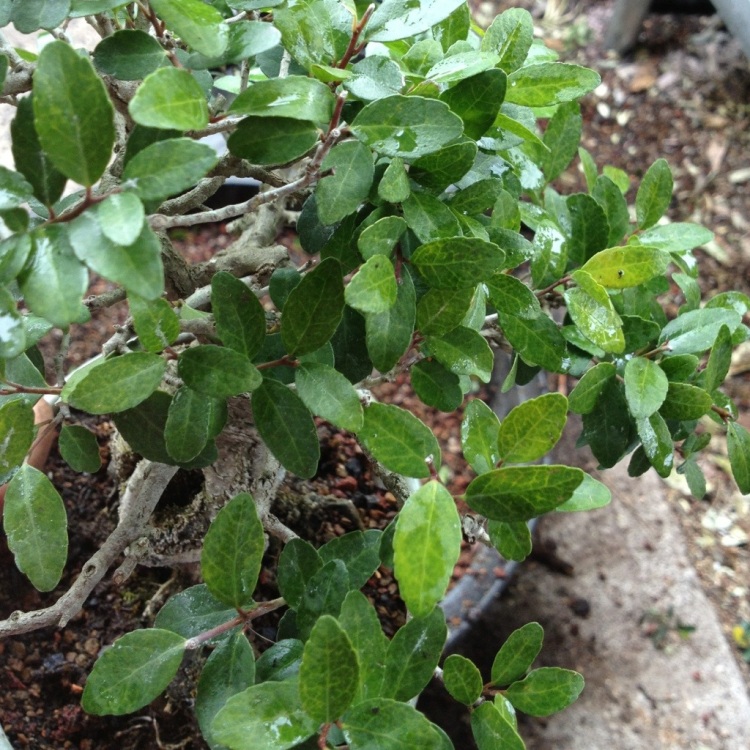
No flowers or new growth. Time for a rejuve.
First step is a bigger pot

The roots aren’t rotting, which is good. But they didn’t fill the pot either.
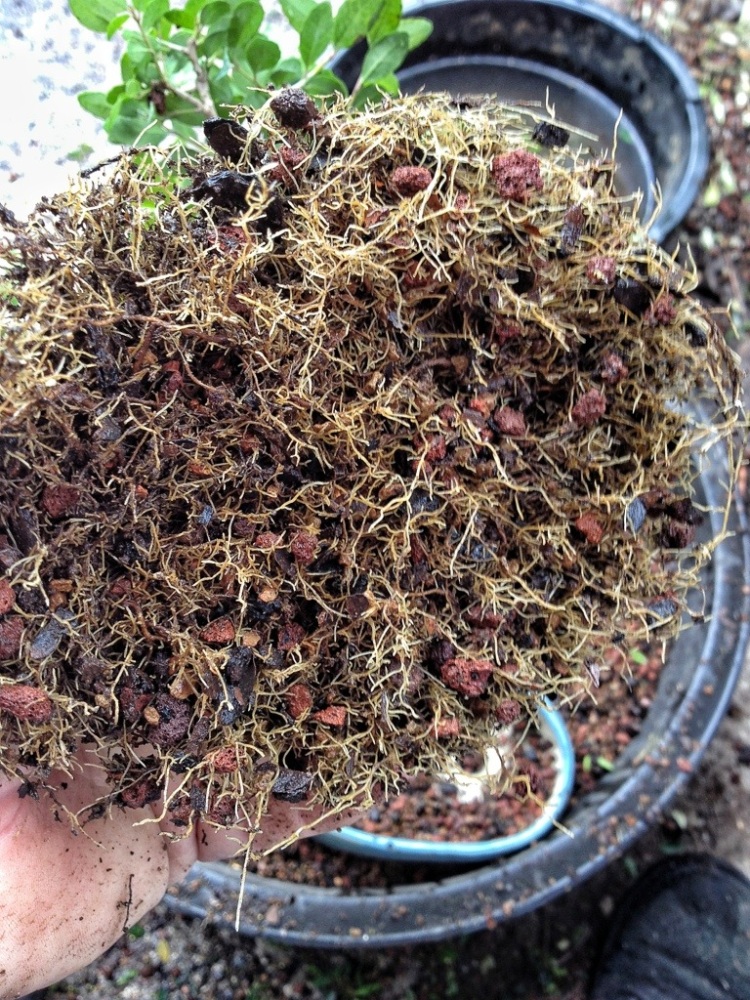
This is one of my oldest ilex. I got it at Walmart as a $3.98 landscape tree in a one gallon pot.
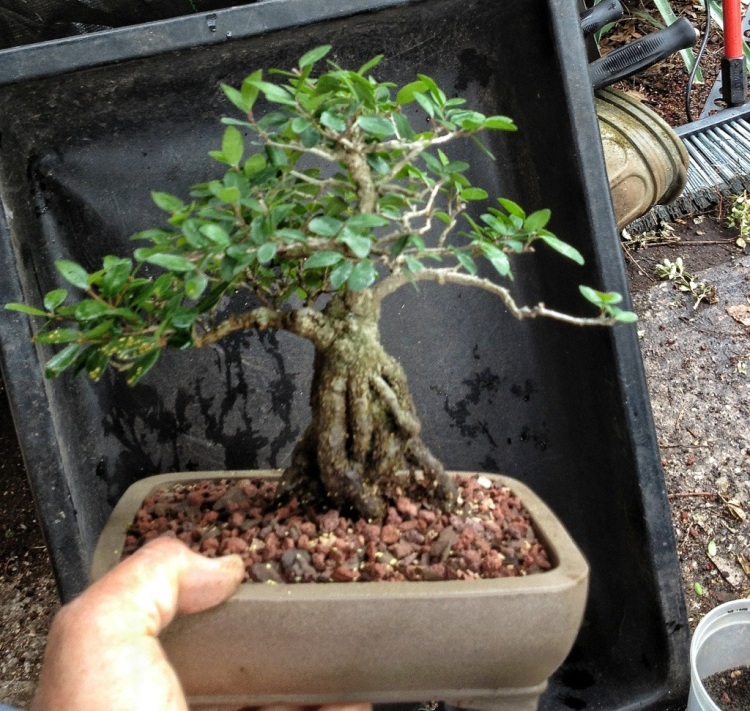
This is it’s home for the next 2 years or so.
Now for after shots…
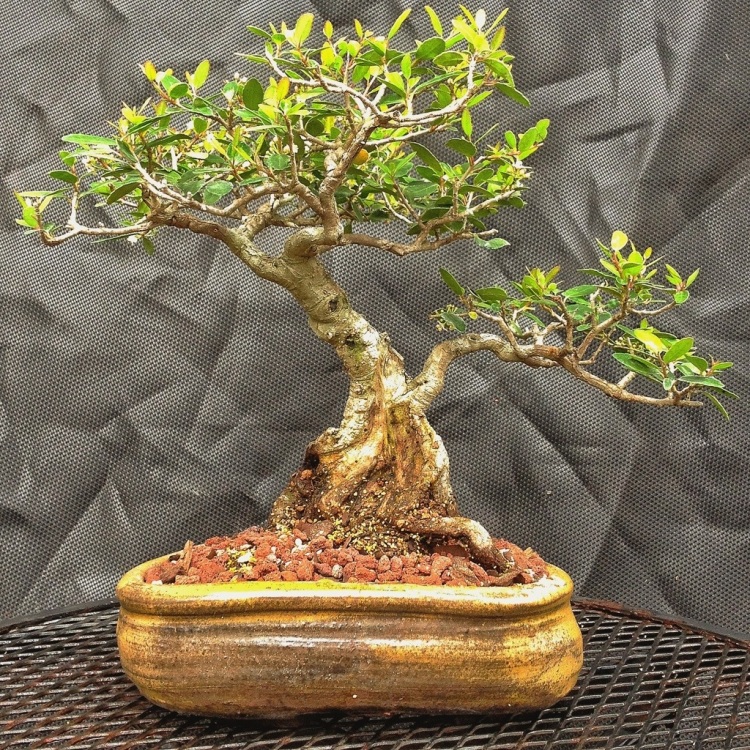
Oo la la!!
Group shot!
All together now!

Enough fooling around! Back to the bench! Only about a hundred more to repot…….
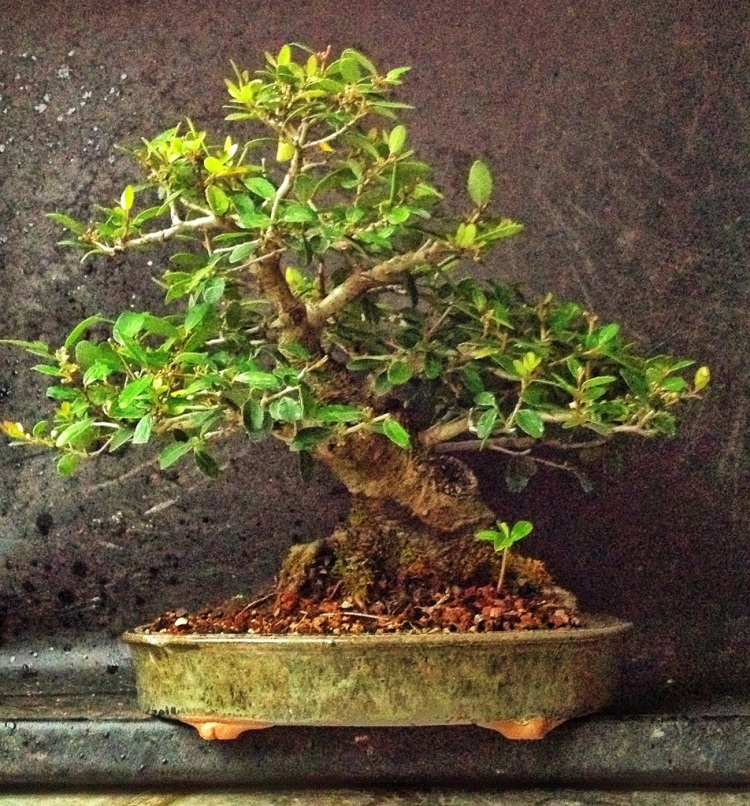
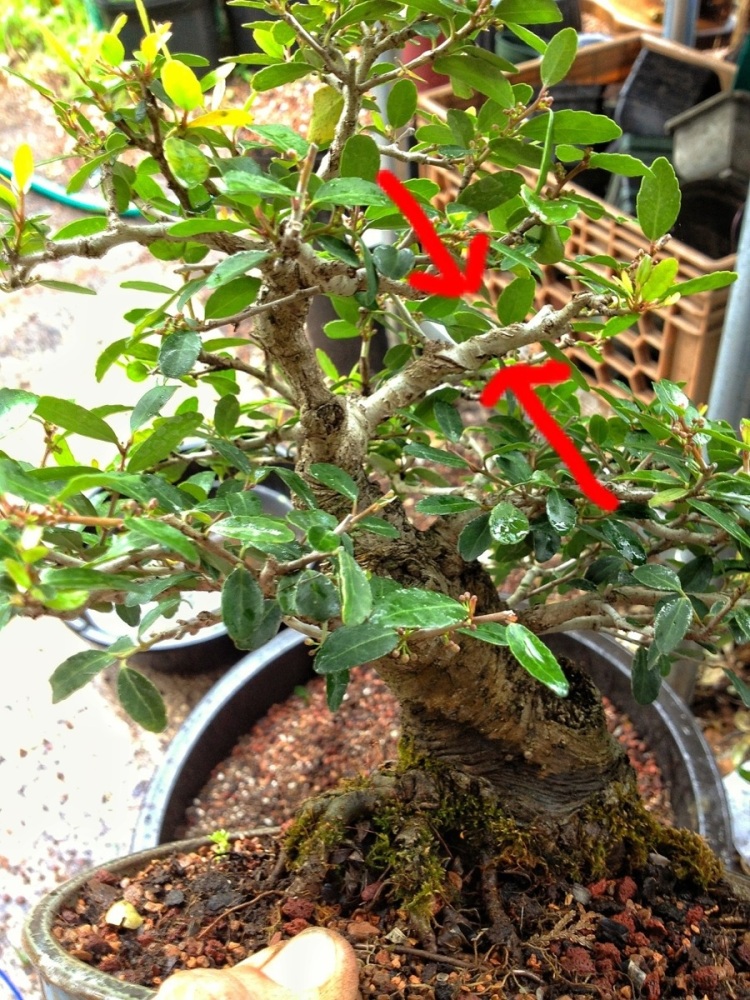
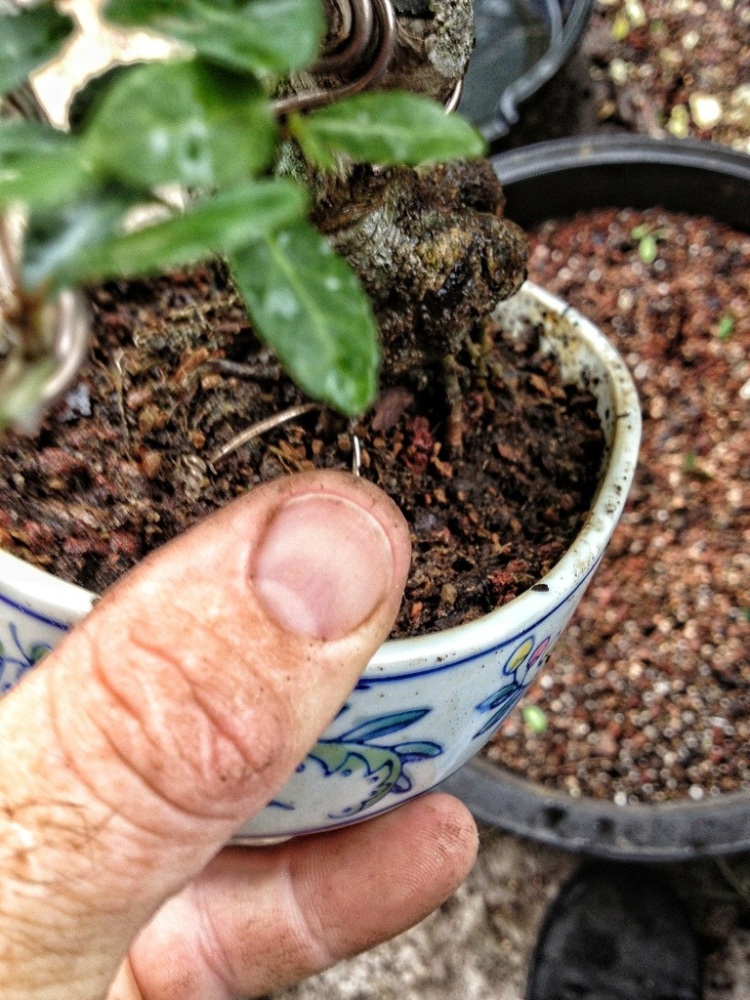
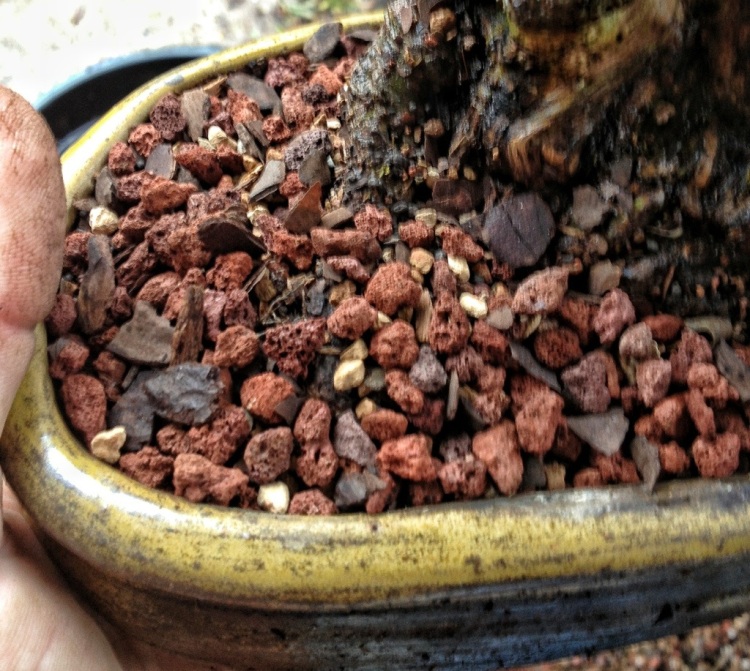
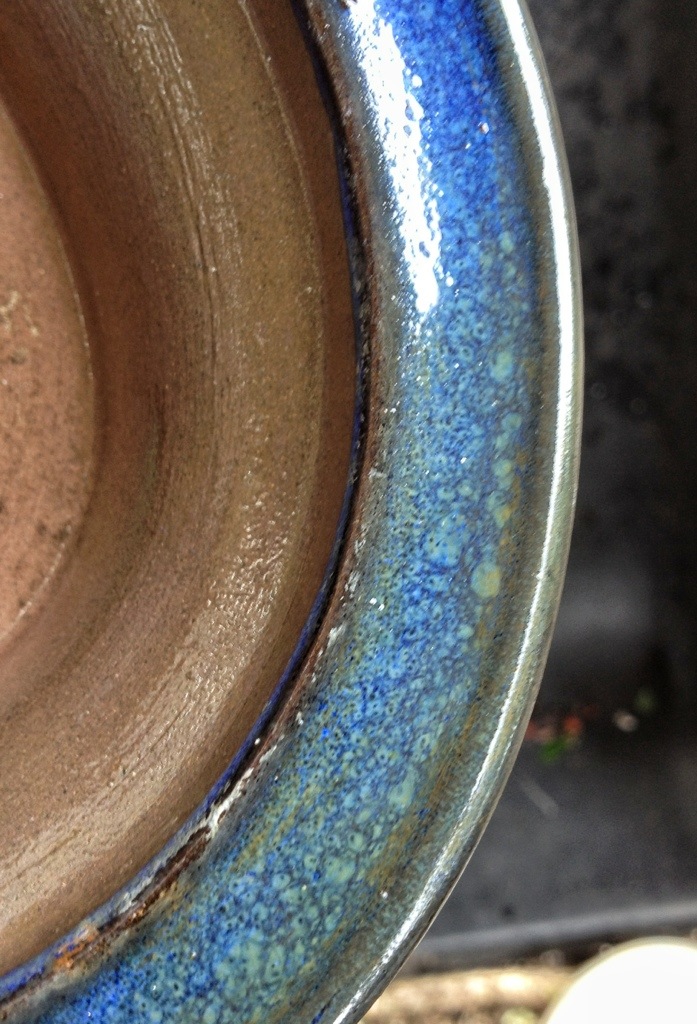

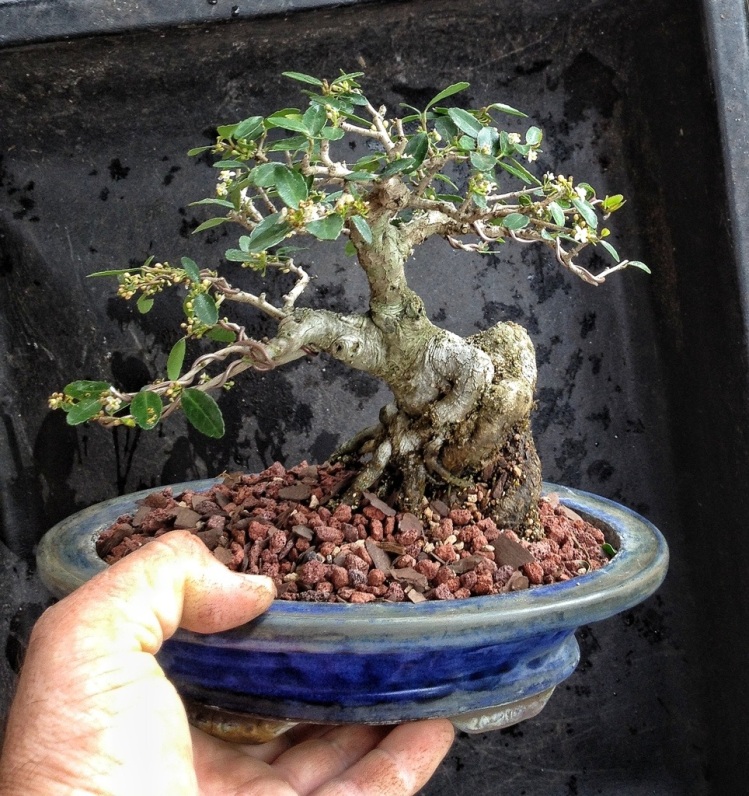
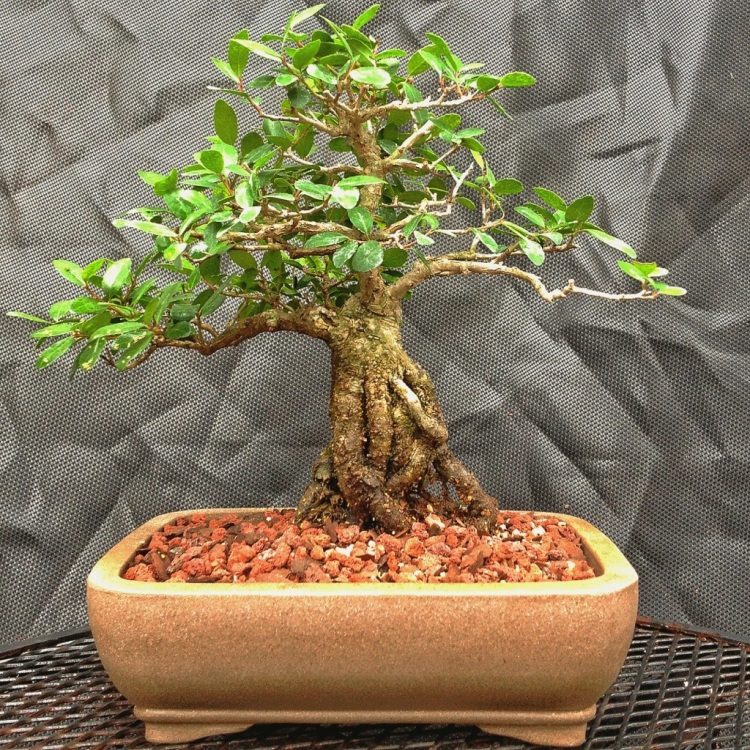

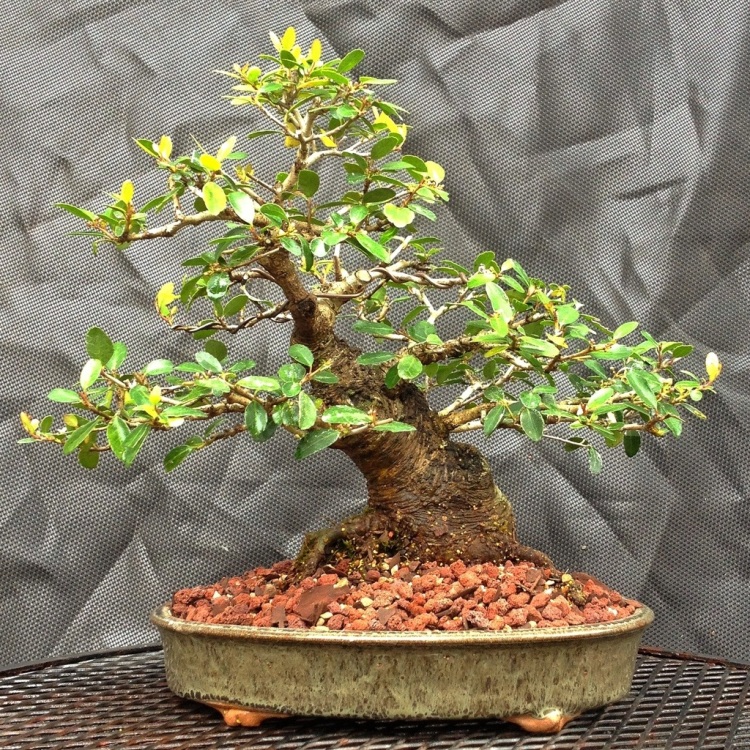

Loved it.
LikeLike
Thanks sir!
LikeLike
Great trees. Are these all Ilex Vomitoria?
LikeLike
Yes. All ilex vomitoria schillings. The dwarf
LikeLike
I like the looks of the Ilex, I don’t think I’ve seen them up here in upstate New York,
especially not at Walmart for $3.98! I guess that’s another reason to move to Florida.
The pots look really good too.
Thanks Adam!
LikeLike
Thanks Bob. They’re a common landscape plant.
LikeLike
Thanks for a great presentation, Adam. I’m impressed! I thought you were strictly into the tropicals. Buxus are my favorites, and Ilex follow a close second. Vomitoria are tough and tolerant little buggers. These are all good pointers I can put to good use; keep them coming.
LikeLike
Adam, you are an Ilex aficionado with a bonsai problem, ha, ha!
Heidi
LikeLike
That’s one way to put it
LikeLike
I agree with the oooo’s and ah’s. Looking good.
LikeLike
Great post! You mentioned buying one of your tress for only $4 at walmart – what time of year did you buy it? How can I cash in on a deal like that (other stores, time of year, what to look for, etc)?
LikeLike
In Florida they sell the one gallon year round. The price has gone up to 5 or six dollars now but that’s still pretty cheap. You just have to search
LikeLike
Adam,
Great results – I would expect nothing less…
LikeLike
Thank you Sharon
LikeLike
The branch death due to over lignification, how is this triggered? Where can I read more about it? It seems like the plant could not even develop properly if that was occurring too much. Does it just occur in a branch here and there and this allows the plant to develop? Weird.
LikeLike
It occurs from pruning. In the landscape you see older ilex hedges with bald spots if the owners have kept the plants too tight.
LikeLike
I have seen I.v. hedges that have dead branches in over clipped spots and seems like more of a disease problem. But I am very curious, I guess physiologically speaking, what triggers the plant to start the lig process? I have looked on line and found nothing about what the plant is doing to kill the branch. Maybe it is one of those, ‘it is what it is’ things, just know that it happens and try and prevent it.
LikeLike
It’s just normal growth that causes lignification. Tree branches need an amount of stiffness to hold themselves up. By us continually pruning a branch, the growth goes into the thickening of the old wood, and in ilex or azaleas, this begins to lessen the sap flow, which then weakens the branch, inviting disease or just killing it.
LikeLike
Thanks. It is what it is, so branch renewal it is. Good to see you are back at it. Hope all goes well for you. Really like your site.
LikeLike
Adam,
Have you air layered the ilex v.?
I haven’t found much info out there.
Thanks
-Zuri
LikeLike
I have not, mostly because they’re so compact (I use the dwarf “schillings” mostly) that an air layer would be impractical. They propagate the species from seed and cuttings mostly. I’ve never heard of air layering.
LikeLike